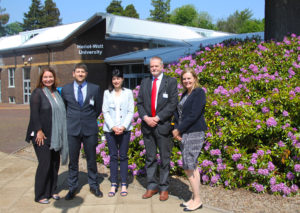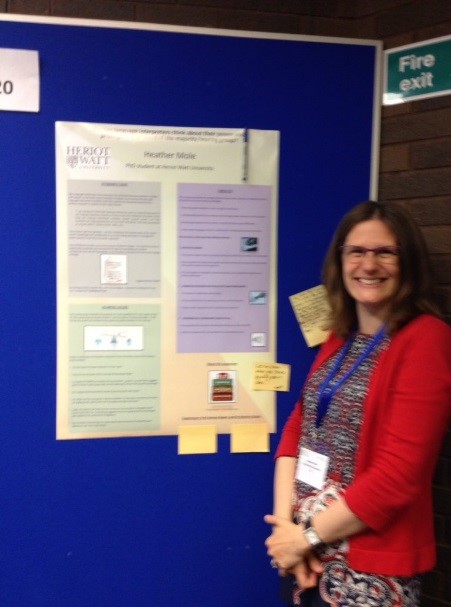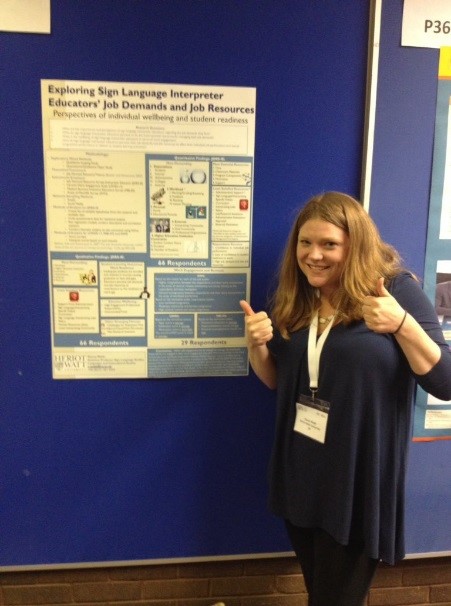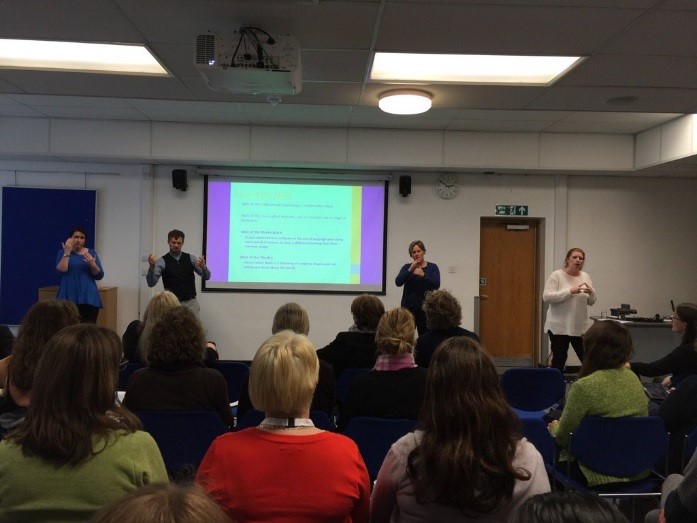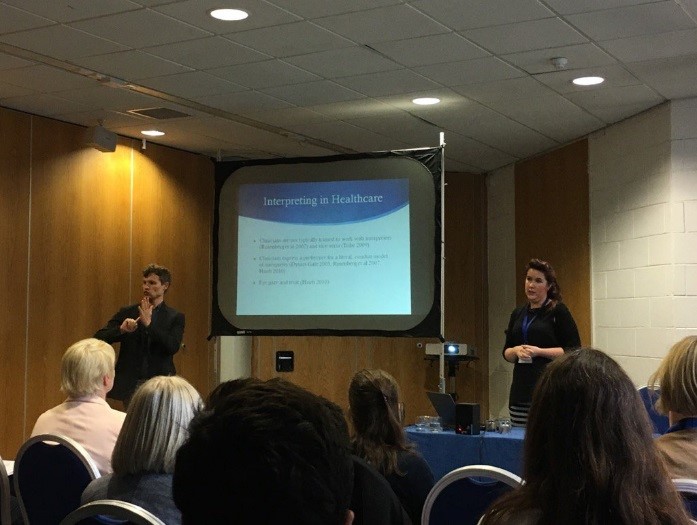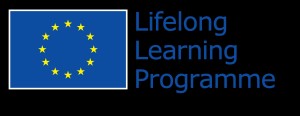By Audrey Cameron & Jemina Napier
Link to version in BSL to be embedded in the website: https://youtu.be/8hJKNgOVbjc

In this blogpost, Jemina Napier and Audrey Cameron provide an update on the work that has been done on the DESIGNS project (promoting access in employment for deaf people) since our last blog/vlog in May 2018.
The past 5 months, work has focused on analysis of the interview data and writing the project report for the European Commission and also disseminating the project data:
- Facebook livestream event in June 2018 with 1,800 viewers
- efsli conference in Croatia in September 2018 – where the theme was “Interpreters working in employment”.
- Association of Sign Language Interpreters (ASLI)’s webinar in September 2018
We are now working on developing training materials for employers and sign language interpreters working with deaf people. There will be two workshops, one in November and another in December:
- Employers’ workshop in partnership with Vercida
- Sign language interpreters’ workshop in partnership with Deaf Action
The next update is due in the New Year.
Below is an English translation of the update that was presented in BSL.
Audrey: We just wanted to update you about some of the exciting work we have been doing on the DESIGNS project over the past 5 months. We have both been busy attending events and letting people know about the project. The report for the European Commission is almost completed and then, after it has formally been presented to them, it will be made available for people to look at.
Jemina: Do you remember back in May, Audrey and I were talking about some of the things we had planned? Well, one of those was a Facebook livestream event, which we did the following month, with Mette Sommer, and Emmy Kauling; Audrey and I talked about the research we are doing here as part of the DESIGNS project and the other two explained about the research they were doing which is about also about deaf people and employment. Amazingly, we got 1,800 views, with people either watching it live, or afterwards when it had been uploaded. So, if you haven’t yet seen it and you’re interested, go to Heriot Watt ‘Life in LINCS’ Facebook page and you’ll see the uploaded video there… wow, when I think about it, one thousand eight hundred views, that’s a lot!

Audrey: I do think that livestreaming is a good way of connecting with the Deaf community and keeping people informed. Whereas in the past, we would need a room and invite people along, this way we can let everybody throughout the whole of the UK know what is going on all at the same time. The other advantage with livestreaming are the questions that people post, which we were then able to respond live and in real time.
Jemina: That’s right, people typed in their comments and they would then pop up – we relayed their questions to everyone in BSL and were able to respond; it is really interactive.
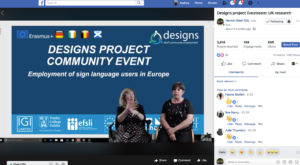
Audrey: What was also good about it was that we had our PowerPoint slides displayed behind us, so that people watching could see the information we were referring to, so hopefully we will line up a few more of those in the coming months.
After the live stream event I went to Croatia for the Efsli (the European Forum of Sign Language Interpreters) conference in Dubrovnik – where the theme was ‘Interpreters working in Employment’ which is obviously the focus of the DESIGNS project. I went to represent the team here in the UK and my colleagues from both Germany and Ireland were also there, along with 300 delegates, most of whom were interpreters from all over Europe. It was fascinating – at the very start of the conference we all took our seats and then the question was asked ‘Who here is from England?’ and they would stand up and everyone would wave. There were loads of different countries represented, I’d say about 30, not just in Europe but from around the world, from Australia, America, Canada, Mexico… it was great for us being able to present the data from this project to so many people; for some it was probably something to bear in mind if they’re looking to improve things in back in their own countries; for others it might have been a reminder that they’d had similar experiences in the past.
Jemina: You gave a presentation at the conference…

Audrey: … yes, along with Christian Rathmann. We had about half an hour to talk about the project. There was one presentation by two designated interpreters from Austria working with a deaf pharmacist. They talked about what it was like – that was good.

What else? This year was the first time they had interpreters from Russia at the conference – there was a booth at the back of the room with an interpreter plugged in with a head mic working into Russian, so that was something a bit different. The presentation from Russia was amazing. They showed a film of all these factories in Russia which have many deaf people working in them and who then all live nearby. There were also photos and apparently, the ratio of interpreters to deaf people is one in fifty. The conference was good and over the two days, there were many references made to deaf employment.
Jemina: After the conference and all those presentations, I recently delivered a training webinar for ASLI, the interpreting association here in the UK. I gave a presentation and facilitated a discussion online and I think we had about 40 participants watching. I explained to them all about the DESIGNS project and picked out some themes from a Europe-wide perspective. Then we focussed in on the UK and I explained how we’d interviewed deaf people, employers and interpreters, so I was talking to them about BSL interpreters and what we’d found here in the UK. It was interesting – there were lots of questions; they were looking for any tips we might have that could help improve things, because they are all too aware of the barriers. Whilst the government makes money available via ATW that does not mean that interpreters are automatically provided and everything goes smoothly, so it was interesting to have that discussion with them, and the feedback from the session was good as well.

Audrey: … and that’s why we’re looking to arrange further training sessions like that including a session in November for employers, because of them don’t know how to recruit deaf people or how to work with interpreters. We are doing that in partnership with Vercida…
Jemina: … Yes, they provide a platform to support employers to recruit disabled people across the board; they have really supported us a lot with this project, helping us to make contact with employers.
Audrey: We are also going to work in with them to set the training for employers and when we have something, we feel works well, we will make it available online and then it will be shared with everyone…
Jemina: … that will act as a pilot. Then we will be doing training for interpreters here in Scotland in partnership with Deaf Action in Edinburgh, where they have an employment service and an interpreting service. The training will be more practical, as opposed to the Asli webinar, which had more of a presentational style, sharing the data and the findings and etc. This will be much more ‘hands on’ for working interpreters. We are hoping to have about 20 interpreters at the session in December.
Audrey: We will be taking all the data we have gathered from the interviews we have conducted and sharing that with employers and interpreters.
Our next whole team project meeting is in Antwerp in Belgium in December where we will be discussing next steps.
Jemina: Plus as a project team we’ll delivering training in partnership with efsli for interpreters from all over Europe and those who train interpreters; that will build on what we’ve done so far and we’ll do that while we’re there in Antwerp. Then a week later, we will both be delivering training here in the UK.
So that’s pretty much everything we are doing…
Audrey: I am looking forward to it. The training is important if we are to start removing the barriers that deaf people face trying to find employment and it is why we are setting that up for employers and interpreters. The training for deaf people will be starting next year, isn’t that right?
Jemina: Yes, exciting times, so keep an eye out for further updates!
*Thanks to Ramon Woolfe for sharing his photos taken at the efsli event.

